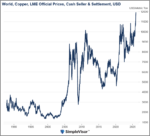The dramatic moves in the money market were investors discounting the acceleration of the tightening cycle among the major economies. Japan is the outlier as the central bank clings to the idea that the rise in price pressures will not be sustained. Other central bankers can talk about being data dependent, but some data are more important than others. Price data and inflation expectation measures are more important than real sector reports. Even after news of the unexpected contraction in May manufacturing output, the first since January, expectations for a 75 bp hike next month edged a little higher.
The dollar spent the first part of June recovering after pulling back in the second half of May. The retracement was deeper than we expected, and the dollar made new highs against sterling and the yen. However, against the other major currencies, last month's highs held. Our reading of the price action and the technical condition warns that the dollar's recovery is over. It is vulnerable to a setback. It dovetails well with a narrative that suggests the market has reached an extreme based on the current information set of a peak in Fed funds around 4.5% next year. It was hovering around 3% at the end of May. Recall that the Fed's median dot suggests a peak funds rate of about 4%. It has been such a rapid adjustment (~150 bp in a couple of weeks) that some consolidation now seems likely.
Another notable development last week was the ECB's emergency meeting that pushed along the process toward crafting a new instrument to resist fragmentation (divergence) within the eurozone bonds markets. The ECB argues that fragmentation interferes with achieving its price stability objective. However, we have argued that 1) such a tool already exists, and 2) a critical hurdle still seems to be strings (conditionality) attached. The earlier tool under was the Outright Market Transactions, aimed at the short end of the coupon curve (1-3 years), and the purchases were to be sterilized to minimize the impact on the balance sheet. However, the innovation now is that the ECB seems to be suggesting that it rather than the country will determine when to trigger it. There seems to be a greater sense (hubris?) that officials can identify what President Lagarde referred to as "irrational" moves.
Dollar Index: The "buy the rumor, sell the fact" after the Fed's 75 bp hike saw the Dollar Index retrace half of this month's rally. It found new bids around 103.50 after setting new highs slightly below 105.80. The MACD is in the middle of its range, but the Slow Stochastic is over-extended and poised to turn lower early next week. The upper Bollinger Band was violated on a closing basis early last week, but the pullback brought into the band again. The upper band begins the near week near 105.50. The Dollar Index looks poised to make a new high, but we will be looking for a reversal pattern or another sign that the bulls are getting tired. That said, the next important technical area is not until 1.08-1.09.
Euro: On June 9, partly in reaction to the ECB meeting, the euro posted a bearish outside day, trading on both sides of the previous session's range and closing below its low. The single currency was stymied around $1.0775. The sell-off extended to about $1.0360, with the low recorded shortly after the FOMC's announcement. Recall that the five-year low set last month was closer to $1.0350. The ECB signaled its commitment to resist significant divergence in the EMU bond market. The combination of this and the US 2-year premium over Germany slipping below 200 bp for the first time in nearly four months helped spur a short-squeeze that lifted the euro, which briefly poked through $1.06. While core-periphery spreads narrowed further ahead of the weekend, the euro lost its mojo and returned to around $1.0440. The MACD is moving lower, and the Slow Stochastic is over-extended. Although it looks like it could turn higher next week, recall that it remained in oversold territory from early April through the middle of May.
Japanese Yen: Japanese officials succeeded in stabilizing the dollar-yen exchange rates despite the stark divergence of monetary policy. Within about 24 hours of the FOMC meeting, the dollar had fallen from a new 22-year high near JPY135.60 to JPY131.50, a nine-day low. The work was undone by the BOJ, which at its meeting gave no sign that it would alter its monetary stance even though the core inflation measure has met its target. While acknowledging that a dramatic fall in the yen is destabilizing, Governor Kuroda did nothing to shake the perception that he favors the direction. The BOJ statement said that it will watch the foreign exchange market and capital markets closely. Does it really tell us anything that we did not know? Continuing to ease policy via the balance sheet and keeping the 10-year yield capped at 0.25% is disrupting the function of the markets, and last week the futures/cash link broke down. The chances of intervention seem even more remote on this side of the BOJ meeting, not that we thought they were particularly high in the first place. The Slow Stochastic has turned down, while the MACD is turning higher from a shallow dip. Still, the dollar looks poised for possibly strong gains next week. There will be more talk of a move toward JPY140.
British Pound: Sterling was squeezed higher after falling to a new two-year low near $1.1935 on June 14. The broad setback in the dollar after the FOMC meeting and the hawkish forward guidance by the Bank of England lifted sterling almost a nickel off the low, a little above $1.24. It met the (61.8%) retracement objective of the decline from the late May high (~$1.2665) that came slightly lower. Support near $1.2170 was tested before the weekend. A break below $1.2100 warns of a return to the lows. Last week, the 3% gain on Wednesday and Thursday was sufficient to turn the Slow Stochastic tentatively higher, but the MACD looks to be rolling back down. June 24 marks the sixth anniversary of the Brexit referendum. It poked a little above $1.50 that day but subsequently fell to $1.3230 and settled around $1.3680.
Canadian Dollar: Ahead of the weekend, the Canadian dollar fell to a new low since November 2020. The risk-off mood, encouraged by many central banks' more aggressive efforts to tighten financial conditions, seems to offset Canada's good macro story. One weight in addition to the S&P 500's (proxy for risk) 5.8% decline last week was the continued reduction in Canada's two-year premium over the US. It had reached a new high for the year of almost 35 bp on June 8 and by the end of last week had fallen to less than five. The momentum indicators give the greenback room to extend what could prove to be an upside break out. The CAD1.3025 area corresponds to the (38.2%) retracement of the greenback's decline from the March 2020 high (~CAD1.4670). The US dollar took it out last month, but it proved a false break. The next retracement (50%) is near CAD1.3340. However, the sharp run-up (from CAD1.2520 on June 8) has pushed the US dollar above the upper Bollinger Band ~CAD1.3035). Canada reports April retail sales next Wednesday and, arguably more important in the current context, May CPI on Thursday. The swaps market is only about halfway toward pricing a 75 bp more instead of 50 at the July 13 Bank of Canada meeting. A strong inflation report could boost the market's confidence.
Australian Dollar: The Australian dollar approached last month's low (~$0.6830) and found a bid near $0.6850. It squeezed to almost $0.7070 after the strong jobs data and hawkish comments from RBA Governor Lowe. However, it appears to be a proverbial dead cat bounce, and before the weekend, it has returned to $0.6900 and the lower Bollinger Band. The two days of gains failed to turn the MACD higher. The Slow Stochastic looked as if it were poised to turn lower, but the poor price action before the weekend means it may not. The futures market now sees the year-end rate near 3.85%, up slightly more than 150 bp over the past two weeks. The rate premium over the US has also jumped, but the Australian dollar depreciated by nearly 4% over those two weeks. A break of $0.6830 could signal a move toward $0.6760, the (50%) retracement of the Aussies' gain since the March 2020 low (~$0.5510). The Australian dollar's correlation with iron ore on a 30-day rolling basis is at a two-year high (0.52), and new Covid restrictions saw iron ore prices fall 14% last week, the biggest weekly decline since last September.
Mexican Peso: The dollar rose by about 2% against the Mexican peso for the second consecutive week, which snapped a five-week slide. Tuesday through Thursday, the greenback stalled in the MXN20.69-MXN20.70 range. That is the highest level since mid-March. The momentum indicators are getting stretched. A break below MXN20.20 may be enough to turn them down. Shortly before Banxico meets on June 23, Mexico will report the mid-June CPI figure. The biweekly measure has been stabilizing between 7.5% and 7.75% for nearly three months. April retail sales will also be reported before the central bank decision. A small decline would not be surprising. There is almost universal agreement that Banxico hikes by 75 bp after moving in 50 bp increments at the last four meetings. The trendline drawn from last November's high (~MXN22.1550) and the March high (~MXN214675) comes near MXN20.76 at the beginning of next week. A break could spur a move toward MXN21.00 initially.
Chinese Yuan: The greenback edged lower against the Chinese yuan last week. In the 15 weeks since the end of February, the dollar has risen against the yuan in all but three weeks. However, the strong uptrend ended a month ago after the dollar peaked around CNY6.8125. Since then, it has been in a range, mostly CNY6.65-CNY6.75. Maybe the CNY6.60-CNY6.80 is acceptable. Chinese stocks bucked the regional and global push lower. The CSI 300 rose 1.65%, its third consecutive weekly gain and the fifth in the past six weeks. It is still off about 12.8% for the year. On the other hand, the Chinese 10-year yield discount to the US widened to 42 bp last week. A small premium had been restored in the second half of May.
Full story here Are you the author? Previous post See more for Next post
Tags: #USD,Featured,newsletter
































